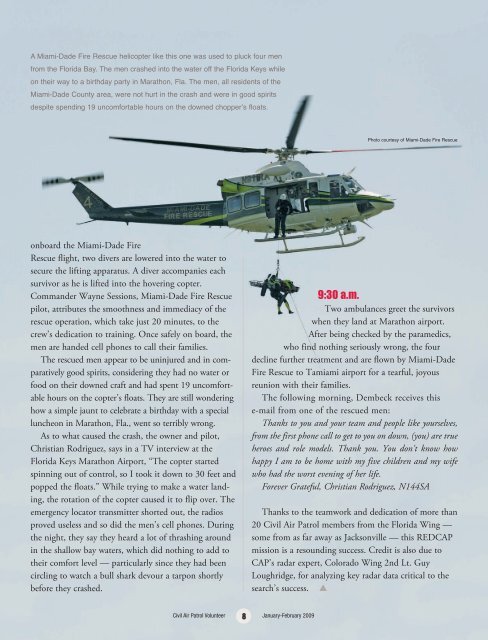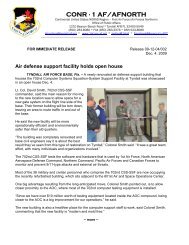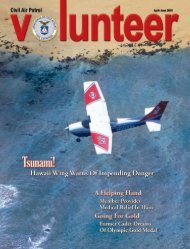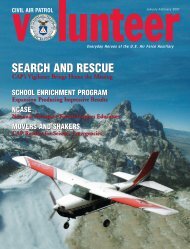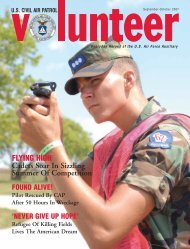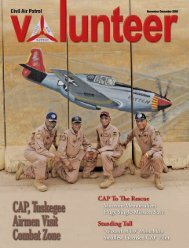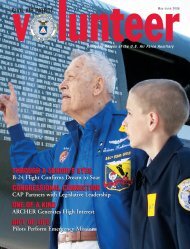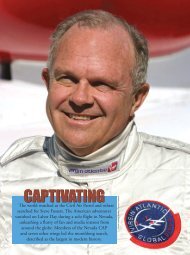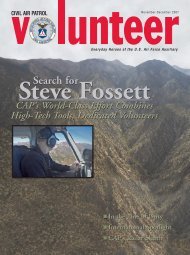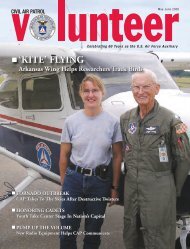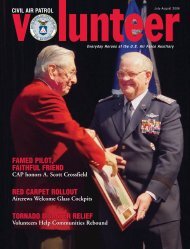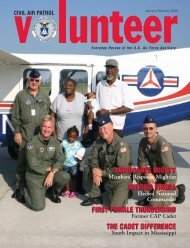Headquarters
High-res - CAP VolunteerNow
High-res - CAP VolunteerNow
You also want an ePaper? Increase the reach of your titles
YUMPU automatically turns print PDFs into web optimized ePapers that Google loves.
A Miami-Dade Fire Rescue helicopter like this one was used to pluck four men<br />
from the Florida Bay. The men crashed into the water off the Florida Keys while<br />
on their way to a birthday party in Marathon, Fla. The men, all residents of the<br />
Miami-Dade County area, were not hurt in the crash and were in good spirits<br />
despite spending 19 uncomfortable hours on the downed chopperʼs floats.<br />
Photo courtesy of Miami-Dade Fire Rescue<br />
onboard the Miami-Dade Fire<br />
Rescue flight, two divers are lowered into the water to<br />
secure the lifting apparatus. A diver accompanies each<br />
survivor as he is lifted into the hovering copter.<br />
Commander Wayne Sessions, Miami-Dade Fire Rescue<br />
pilot, attributes the smoothness and immediacy of the<br />
rescue operation, which take just 20 minutes, to the<br />
crew’s dedication to training. Once safely on board, the<br />
men are handed cell phones to call their families.<br />
The rescued men appear to be uninjured and in comparatively<br />
good spirits, considering they had no water or<br />
food on their downed craft and had spent 19 uncomfortable<br />
hours on the copter’s floats. They are still wondering<br />
how a simple jaunt to celebrate a birthday with a special<br />
luncheon in Marathon, Fla., went so terribly wrong.<br />
As to what caused the crash, the owner and pilot,<br />
Christian Rodriguez, says in a TV interview at the<br />
Florida Keys Marathon Airport, “The copter started<br />
spinning out of control, so I took it down to 30 feet and<br />
popped the floats.” While trying to make a water landing,<br />
the rotation of the copter caused it to flip over. The<br />
emergency locator transmitter shorted out, the radios<br />
proved useless and so did the men’s cell phones. During<br />
the night, they say they heard a lot of thrashing around<br />
in the shallow bay waters, which did nothing to add to<br />
their comfort level — particularly since they had been<br />
circling to watch a bull shark devour a tarpon shortly<br />
before they crashed.<br />
9:30 a.m.<br />
Two ambulances greet the survivors<br />
when they land at Marathon airport.<br />
After being checked by the paramedics,<br />
who find nothing seriously wrong, the four<br />
decline further treatment and are flown by Miami-Dade<br />
Fire Rescue to Tamiami airport for a tearful, joyous<br />
reunion with their families.<br />
The following morning, Dembeck receives this<br />
e-mail from one of the rescued men:<br />
Thanks to you and your team and people like yourselves,<br />
from the first phone call to get to you on down, (you) are true<br />
heroes and role models. Thank you. You don't know how<br />
happy I am to be home with my five children and my wife<br />
who had the worst evening of her life.<br />
Forever Grateful, Christian Rodriguez, N144SA<br />
Thanks to the teamwork and dedication of more than<br />
20 Civil Air Patrol members from the Florida Wing —<br />
some from as far away as Jacksonville — this REDCAP<br />
mission is a resounding success. Credit is also due to<br />
CAP’s radar expert, Colorado Wing 2nd Lt. Guy<br />
Loughridge, for analyzing key radar data critical to the<br />
search’s success. ▲<br />
Civil Air Patrol Volunteer 8 January-February 2009


